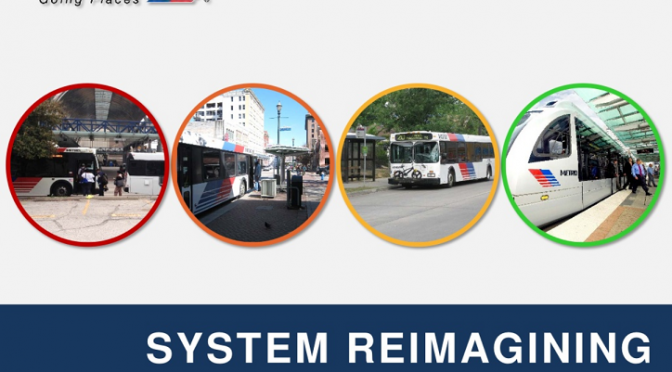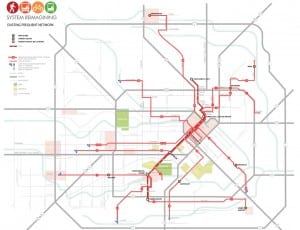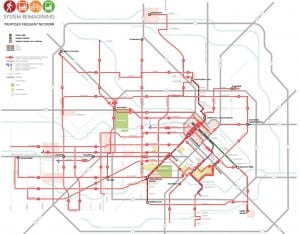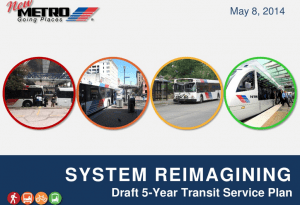At over 2.2 million residents and over 600 square miles in land area, Houston has the unique distinction of not only being one of the largest cities in the US by population, but also one of the most spread-out cities. This reality can be quite the challenge when trying to plan for the for the transit needs of so many people in such a large space. Also, as more citizens discover the benefits of public transit options, demand for quality service increases.
Which is why public transit advocates have been awaiting some big news, as Houston METRO considers a total transformation of its existing bus network. Last week, that news was revealed as the transit re-imagining plan. And as promised, it is a total transformation.
From the slideshow presentation, Here are the basic goals:
System Re-imagining delivers a transit network that…
-
Has more frequent routes to more places
-
Is much easier to understand and use
-
Connects more people to more jobs
-
Provides much better weekend service
-
Better serves METRO’s current riders
-
Provides faster, more reliable trips
-
Is built to support future growth.
Job centers are a big stress of this plan, with improved service to all of Houston’s major employment hubs. At present, METRO has a lot of duplicating routes… multiple buses that travel on the same thoroughfare for an extended amount of time. Under the new plan, those duplicated routes are virtually wiped away, in favor a simpler system. This also would allow those simplified routes to run more frequently, which decreases wait times at stops. What METRO calls its Frequent Network… buses that run every 15 to 20 minutes, would be dramatically expanded.
Here’s a look at METRO’s current Frequent Network…
And here is what the proposed re-imagining would move to…
Clearly, the plan covers a wider area of the city, and stresses more reliable connections. Of course this is at the expense of other routes, many of which are in areas that depend on METRO’s services the most. The solution proposed for those cuts is called a Flex Zone… an area that operates essentially as a ride-share service instead of having fixed route coverage. If one is in the Flex Zone, they would have to call ahead and schedule a ride (this is already done under the current MetroLift service) which would then take them to the nearest fixed route service. Most of the Flex Zones are located in Northeast Houston.
Overall, this is a great first draft, and will represent a significant improvement over the current public transit network. If METRO can deliver 10 to 15 minute service in the Frequent Network as promised, it will undoubtedly attract more riders to the system.
But the greatest concern here are the Flex Zones… especially that they are all in one concentrated area. A call-in service may work for home-bound citizens, but it’s not a practical solution for frequent travelers that have jobs, children to support and other basic needs. After spending billions of dollars to build the North, East and Southeast rail lines, it appears that these transit stops are being underutilized in the current iteration of re-imagining. For example, the current route 52 Hirsch/ Scott is consistently one of the highest ridership routes in METRO’s system, with a northern terminus at Mesa Transit Center. But under re-imagining, Mesa TC will be left with significantly reduced transit coverage, serviced by just three routes, and no frequent network coverage. Additional connections to either Kashmere TC’s frequent route, or to Northline Station could be a low-cost solution that would decrease the need for such large Flex Zones in the area.
There are definitely some kinks to work out with this, but on the whole this is good plan for Houston’s transit future. The public comment period for System Re-imagining is going on now, so this is the time to take a look at the new system, and leave METRO your feedback. This is a bold opportunity to guide the future of Houston transit, so let’s be a part of it.




That about sums up my feelings as well. I’m doubtful on the Flex plan and no red routes to the northeast, but laud the rest of the map.